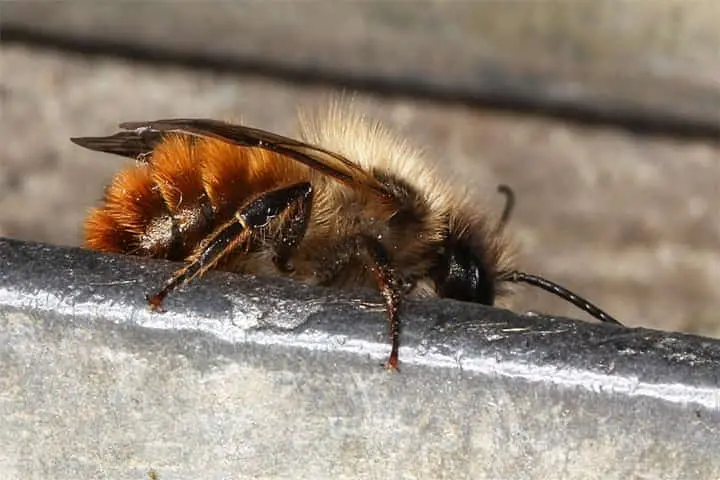

The gut microbiome of bees contains clues regarding their health
<p>
The local environment plays a pivotal role in the health and diversity of the gut microbiome of wild bees which could help detect invisible stressors and early indicators of potential threats, say York University scientists in a new study.</p>
<p>
The findings were published in the journal Communications Biology. Piloting a new frontier of metagenomics, the researchers sequenced whole genomes of three species of carpenter bees, a type of wild bee, in North America, Asia and Australia. This analysis allowed them to gain insights into the bee&#39;s gut microbiome (bacteria and fungi), diet, and viral load, as well as their environmental DNA.</p>
<p>
Unlike social bees (like honeybees and bumblebees), the researchers found solitary bees get their microbiome, which is important for health, from their environment where they forge for food, rather than inheriting it from their nest mates. Carpenter bees burrow into woody plant stalks to lay eggs rather than in hives.</p>
<p>
&quot;This may make them better bio-indicators as they are much more sensitive to their environment,&quot; says Faculty of Science Associate Professor Sandra Rehan, corresponding author of the research, Comparative metagenomics reveals expanded insights into intra- and interspecific variation among wild bee microbiomes.</p>
<p>
In Australia, the local populations had highly distinctive metagenomes and microbiomes; so much so that machine learning tools were able to reliably predict from which population each bee was drawn.</p>
<p>
The research team also discovered crop pathogens in the microbiomes of carpenter bees which were previously only found in honeybees.</p>
<p>
&quot;These pathogens are not necessarily harmful to bees, but these wild bees could potentially be vectoring diseases that might have negative effects on agriculture,&quot; says Rehan. Finding out how these pathogens are spreading in wild bees is important as bees contribute to ecological and agricultural health worldwide in addition to more than $200 billion in annual agricultural services.</p>
<p>
Establishing a baseline of what a healthy microbiome looks like in wild bees allows scientists to compare species across continents and populations, and to figure out how diseases and harmful microbiota are being introduced and transmitted.</p>
<p>
&quot;We can really dissect bee health in a very systematic way looking at population genetics and parasite pathogen loads, healthy microbiomes and deviations,&quot; says Rehan, whose Postdoctoral Research Associate, Wyatt Shell, led the study. &quot;The long-term goal is really to be able to use these tools to be able to also detect early signatures of stress and habitats in need of restoration or conservation. To develop it almost like a diagnostic tool for bee health.&quot;</p>
<p>
Researchers believe they have captured the core microbiome of carpenter bees for the first time. They found beneficial bacteria in all three carpenter bee species which helped with metabolic and genetic functions. They also detected species of Lactobacillus, which is an essential beneficial bacteria group, imperative for good gut health and found across most bee lineages. Lactobacillus may protect against prevalent fungal pathogens, boost the immune system, and facilitate nutrient uptake.</p>
<p>
However, a recently published paper in the journal Environmental DNA by Rehan and her graduate student Phuong Nguyen, Developmental microbiome of the small carpenter bee, Ceratina calcarata, which studied the microbiome in brood and adult carpenter bees in cities, found they were lacking Lactobacillus.</p>
<p>
&quot;This raises red flags,&quot; says Rehan. &quot;We are continuing those studies to look at more nuanced urban, rural comparisons and long-term data to really understand these environmental stressors. Anytime we characterize a microbiome and see deviations from what we know to be normal, it can give us an indication of a population or species in threat.&quot;</p>
<p>
Overall, the results show metagenomic methods could provide important insights into wild bee ecology and health going forward.</p>
<p>
&quot;We&#39;ve been piloting this research approach in a few species, but we&#39;re aiming to study dozens of wild bee species and broader comparisons are coming. These two studies are really establishing the foundation,&quot; she says. &quot;The long-term goal is really to be able to use these tools to detect early signatures of stress in wild bees and thereby identify habitats in need of restoration or preservation. We are excited to be building the tools for a new era of wild bee research and conservation.&quot;</p>
<p>
<strong>Also read: <a href="https://www.indianarrative.com/science-news/citing-of-polar-bears-in-greenland-cheers-conservationists-178162.html">Citing of polar bears in Greenland cheers conservationists</a></strong></p>
The Government of Myanmar has expressed deep gratitude for India's swift and substantial support in…
Protesters affected by the Diamer-Bhasha Dam project offered Eid-ul-Fitr prayers at their ongoing protest camp…
External Affairs Minister S. Jaishankar recognised the screening of 'The Diplomat' in Israel for a…
By Rajnish Singh Operation Brahma by India is operating at full tilt aimed towards providing…
Indian Naval Ship (INS) Tarkash successfully intercepted and seized over 2500 kg of narcotics in…
The Rajasthan Samagra Kalyan Sansthan (RSKS India) made a significant impact during the 58th session…